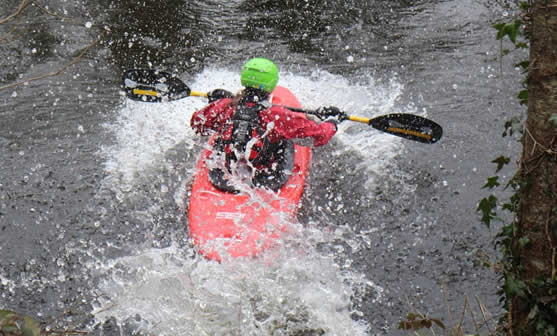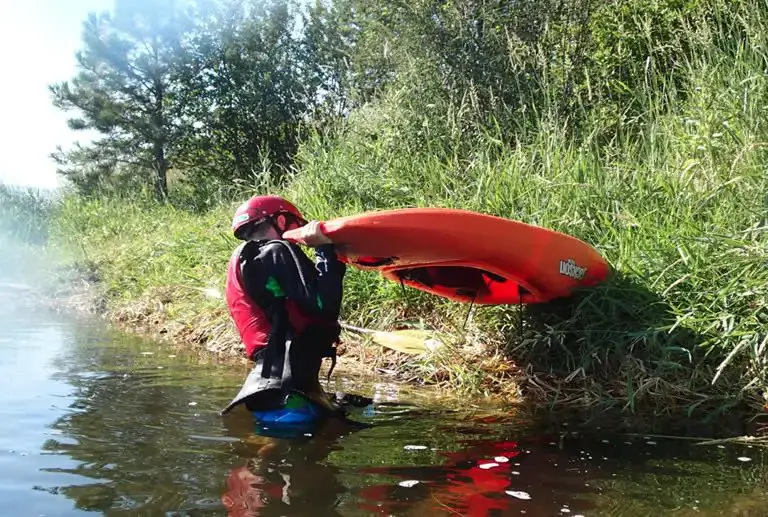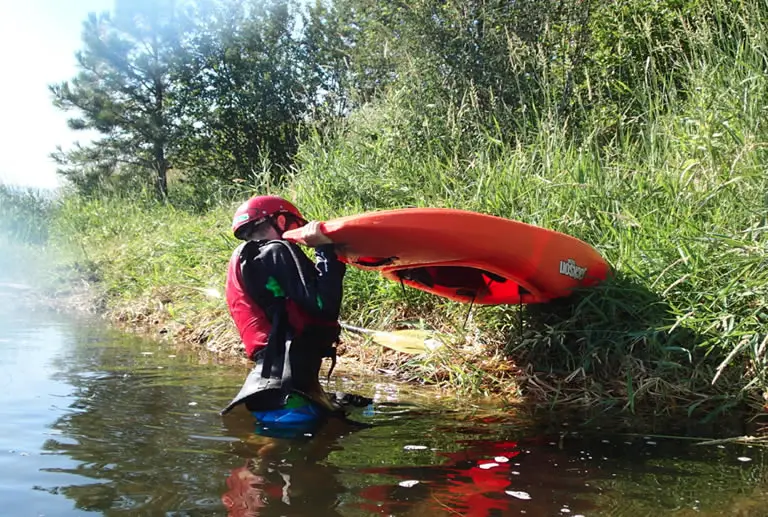Contents
How To Get Water Out Of A Kayak
So, how do you get water out of a kayak?
The most common way of getting water out of a sit-in kayak is to tip the boat over and allow the water to run out.
For a sit-on-top kayak you should remove the drain plugs.
However, these steps don’t always drain away all the water.
By far the easiest way to get water out of a kayak, especially if you are out on the water, is to use a lightweight, hand-operated bilge pump that you can easily carry with you while paddling.
A sponge can also be used to soak up any remaining water.
Emptying a kayak that is filled with water and can be a difficult task.
Water is heavy.
A water-filled kayak is heavier.

If there are 2 or more people then this weight issue is less of a problem but if you have to tackle the situation on your own it becomes a much bigger problem.
I will address a way to deal with this later in the article.
There are two different ways to approach the problem of getting water out of your kayak; tackling the problem on dry land and tackling it when out on the water.
There are also different methods employed for removing water from a kayak based on the type of kayak you are using.
Draining water from inside a sit-on-top kayak
It is much easier to get water out of a sit-on-top kayak than a sit-in kayak.
Inside a sit-on-top kayak there are scupper holes which are designed to drain away any water that gets onto the deck of the boat.
Sometimes these scupper holes get clogged and need to be cleaned.
If the holes are clogged with dirt or grime, even if not fully clogged, water will be unable to escape through the hole.
Have a quick check to see if the scupper holes and are clogged and, if they are, clean them. The water will then drain away.
You should also note that in certain situations it is actually a good idea to deliberately block these scupper holes, such as in high waves when the holes will let in more water than they let out.

So, check to see if the scupper holes have been blocked by drain plugs.
If there are drain plugs in the holes simply remove them and the water will drain away on its own.
Draining water from inside a sit-in kayak
A sit-in kayak has a completely different hull design from a sit-on-top kayak and does not have any scupper holes.
If there are holes in your boat that look like scupper holes you have problem – they are just regular holes and that is probably where the water is getting in. 😉
To drain a sit-in kayak of water most paddlers will flip their boat over and tilt it up to allow the water to flow down towards the cockpit and out.
Obviously this isn’t fail-proof and most of the time enough water remains in the boat for it to be annoying.
Some sit-in kayak owners will install a scupper hole at the tip of the boat.
This scupper hole most always have a drain plug in it while using the boat.
However, once on dry land the kayak can then been lifted up and then the drain plug can be removed and the water will drain from the scupper hole.
Just remember to put the drain plug back in the hole before you hit the water.
This approach is most beneficial to those kayakers who like to take to the ocean, or go on boat camping trips in long touring kayaks.
A touring kayak, also known as a sea kayak, has a hull design that makes it difficult to get water out by just tipping the boat or even using a bilge pump (as the hose usually isn’t long enough).
Getting water out of a kayak while paddling on the water
Now let’s look at how you can get water out of your kayak when out on the water.
Having a kayak fill with water while paddling on the water offers different drainage problems that those encountered on land.
Obviously you cannot tip the boat, and messing around with scupper holes while paddling is also usually not an option.
So how do you get water out of the inside of your kayak while you are still out on the water?
The first step is to take inventory of your situation.
How much water is in the kayak? Is water still getting in?
If the kayak is not in danger of sinking then you have 2 options:
- Head for shore and tip the kayak to drain it. You will probably have to do this numerous times before you get all the water out.
- Use a portable lightweight bilge pump
to remove most of the water before heading for shore. Then use a sponge to soak up the remaining water.
If your kayak has an access of water that is weighing the boat down you need to head for shore and drain the boat.
If the boat is in the process of taking-on water and the water is building-up then you need to get to shore as quickly as you can.
If your kayak is filling up with water and starting to sink you may be better exiting the boat and swimming to shore, while you pull your kayak along with you (if possible).
Simply take hold of a grab rail at the bow or stern end and swim for shore.
The smartest and easiest way to get water out of a kayak
The easiest option for removing water from any type of kayak on both land and on the water is a simple portable, hand-operated, bilge pump.
Bilge pumps come in all shapes and sizes but there are small, very lightweight bilge pumps that are perfect for kayakers.

Hand operated, lightweight bilge pumps, like this one, can be attached to a PFD or placed on the deck, or inside the cockpit, for use whenever needed.
This means you have a quick way of pumping out water from inside the kayak on both land and while still out on the water.
Another other way to get water out of a kayak
A simple sponge can work wonders to soak up those final drops of water that tipping the boat didn’t get out and even the bilge pump couldn’t drain away.
Dipping the sponge into the water and allowing it to soak it up is not the best way to remove the bulk of the water as it is too time-consuming though.
However, once your kayak is mostly empty of water a big sponge will really help to soak up the rest of it.
A sponge is also light and very easy to store.
How to avoid water getting into a kayak in the first place
If you are using a sit-in kayak then the best way to avoid getting water into the boat is to use a spray skirt.
A spray skirt will fit snugly over the cockpit and act as a waterproof barrier for the inside of your kayak.
If you fit a spray skirt to your boat (correctly) and water is still getting inside you have a leak, most likely coming through lose fitting or a damaged storage hatch.
If this is the case, or you have a recurring problem with water getting into your boat, you should read our article why does my kayak fill with water to find the solutions to these problems.

